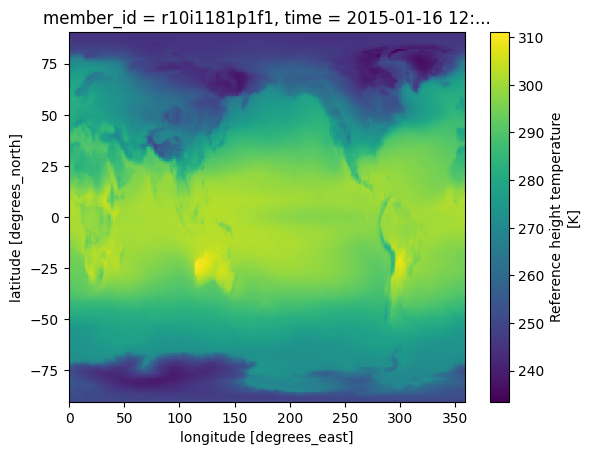Table of Contents¶
Section 1: Introduction¶
- Python package imports and useful function definitions
# Display output of plots directly in Notebook
%matplotlib inline
import warnings
warnings.filterwarnings("ignore")
import intake
import numpy as np
import xarray as xr
import nc_time_axisimport dask
from dask_jobqueue import PBSCluster
from dask.distributed import Client
from dask.distributed import performance_reportlustre_scratch = "/lustre/desc1/scratch/harshah"
#
catalog_url = 'https://data-osdf.gdex.ucar.edu/ncar-gdex/d010092/catalogs/d010092-osdf-zarr.json'
# catalog_url = 'https://stratus.gdex.ucar.edu/d010092/catalogs/d010092-https-zarr.json' #NCAR's Object store# GMST function ###
# calculate global means
def get_lat_name(ds):
for lat_name in ['lat', 'latitude']:
if lat_name in ds.coords:
return lat_name
raise RuntimeError("Couldn't find a latitude coordinate")
def global_mean(ds):
lat = ds[get_lat_name(ds)]
weight = np.cos(np.deg2rad(lat))
weight /= weight.mean()
other_dims = set(ds.dims) - {'time','member_id'}
return (ds * weight).mean(other_dims)Section 2: Select Dask Cluster¶
- Setting up a dask cluster. You will need to choose the type of cluster based on your use case.
- The default will be LocalCluster as that can run on any system.
- If running on NCAR’s HPC i.e, Casper with a PBS Scheduler, set USE_PBS_SCHEDULER to True. Otherwise, set to False.
USE_PBS_SCHEDULER = TrueIf running on Jupyter server with Dask Gateway configured, set to True. Otherwise, set to False.
USE_DASK_GATEWAY = FalsePython function for a PBS cluster¶
# Create a PBS cluster object
def get_pbs_cluster():
""" Create cluster through dask_jobqueue.
"""
from dask_jobqueue import PBSCluster
cluster = PBSCluster(
job_name = 'dask-osdf-25',
cores = 1,
memory = '4GiB',
processes = 1,
local_directory = lustre_scratch + '/dask/spill',
log_directory = lustre_scratch + '/dask/logs/',
resource_spec = 'select=1:ncpus=1:mem=4GB',
queue = 'casper',
walltime = '3:00:00',
#interface = 'ib0'
interface = 'ext'
)
return clusterPython function for a Gateway Cluster¶
def get_gateway_cluster():
""" Create cluster through dask_gateway
"""
from dask_gateway import Gateway
gateway = Gateway()
cluster = gateway.new_cluster()
cluster.adapt(minimum=2, maximum=4)
return clusterPython function for a Local Cluster¶
def get_local_cluster():
""" Create cluster using the Jupyter server's resources
"""
from distributed import LocalCluster, performance_report
cluster = LocalCluster()
return clusterPython logic to select the Dask Cluster type¶
- This uses True/False boolean logic based on the variables set in the previous cells
# Obtain dask cluster in one of three ways
if USE_PBS_SCHEDULER:
cluster = get_pbs_cluster()
elif USE_DASK_GATEWAY:
cluster = get_gateway_cluster()
else:
cluster = get_local_cluster()
# Connect to cluster
from distributed import Client
client = Client(cluster)cluster.scale(4)
client.wait_for_workers(4)
clusterLoading...
Section 3: Data Loading¶
- Load CESM2 LENS zarr data from GDEX using an intake-ESM catalog
- For more details regarding the dataset. See, https://
gdex .ucar .edu /datasets /d010092 /#
# Open collection description file using intake
col = intake.open_esm_datastore(catalog_url)
colLoading...
cesm_temp = col.search(variable ='TREFHT', frequency ='monthly')
cesm_tempLoading...
cesm_temp.df['path'].valuesarray(['https://stratus.gdex.ucar.edu/d010092/atm/monthly/cesm2LE-historical-cmip6-TREFHT.zarr',
'https://stratus.gdex.ucar.edu/d010092/atm/monthly/cesm2LE-historical-smbb-TREFHT.zarr',
'https://stratus.gdex.ucar.edu/d010092/atm/monthly/cesm2LE-ssp370-cmip6-TREFHT.zarr',
'https://stratus.gdex.ucar.edu/d010092/atm/monthly/cesm2LE-ssp370-smbb-TREFHT.zarr'],
dtype=object)dsets_cesm = cesm_temp.to_dataset_dict()Loading...
dsets_cesm.keys()dict_keys(['atm.historical.monthly.cmip6', 'atm.ssp370.monthly.cmip6', 'atm.historical.monthly.smbb', 'atm.ssp370.monthly.smbb'])historical_cmip6 = dsets_cesm['atm.historical.monthly.cmip6']
future_cmip6 = dsets_cesm['atm.ssp370.monthly.cmip6']future_cmip6 Loading...
Make a quick plot to check data transfer¶
%%time
future_cmip6.TREFHT.isel(member_id=0,time=0).plot()CPU times: user 216 ms, sys: 18.6 ms, total: 234 ms
Wall time: 2.44 s

Section 4: Data Analysis¶
- Perform the Global Mean Surface Temperature computation
Merge datasets and compute Global Mean surrface temperature anomaly¶
- Warning! This section takes about a min to run!
- Config: 3 dask workers with 8GiB memory.
merge_ds_cmip6 = xr.concat([historical_cmip6, future_cmip6], dim='time')
# merge_ds_cmip6 = merge_ds_cmip6.dropna(dim='member_id')
merge_ds_cmip6 = merge_ds_cmip6.TREFHT
merge_ds_cmip6Loading...
Compute (spatially weighted) Global Mean¶
ds_cmip6_annual = merge_ds_cmip6.resample(time='AS').mean()
ds_cmip6_annualLoading...
%%time
gmst_cmip6 = global_mean(ds_cmip6_annual)
gmst_cmip6 = gmst_cmip6.rename('gmst')
gmst_cmip6Loading...
Compute anomaly and plot¶
gmst_cmip6_ano = gmst_cmip6 - gmst_cmip6.mean()
gmst_cmip6_anoLoading...
gmst_cmip6_ano = gmst_cmip6_ano.compute()%%time
gmst_cmip6_ano.mean(dim='member_id').plot()CPU times: user 25.5 ms, sys: 0 ns, total: 25.5 ms
Wall time: 28.4 ms

cluster.close()